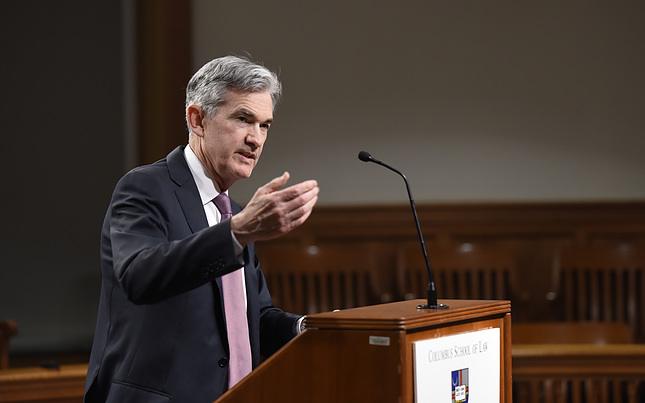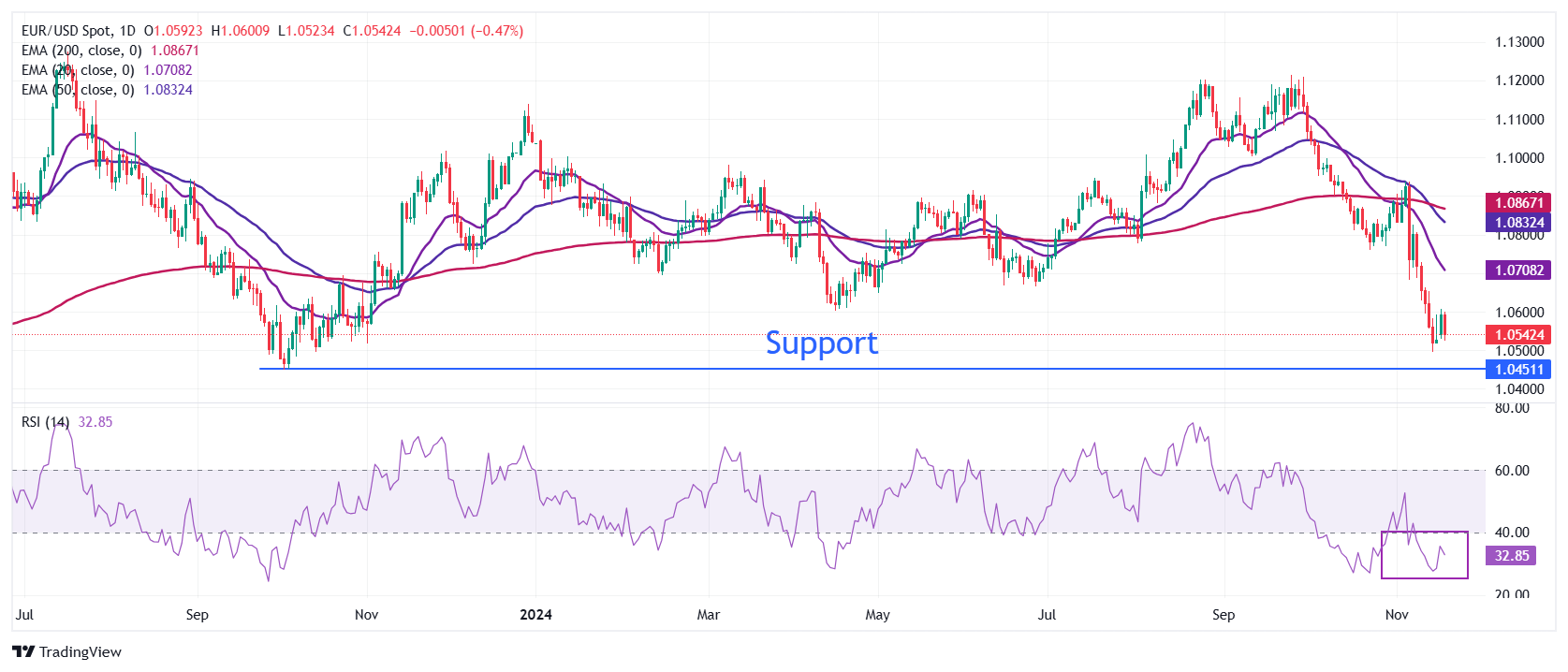- EUR/USD faces resistance near 1.0600 on Tuesday as investors see more upside in the US Dollar.
- The focus of ECB officials turns toward preserving growth rather than taming price pressures.
- Trump’s policies are expected to boost US inflation and economic growth.
EUR/USD struggles to extend Monday’s recovery above the immediate resistance of 1.0600 and edges lower in Tuesday’s European session. It appears that the recovery from the yearly low around 1.0500 last week in the major currency pair losses steam as European Central Bank (ECB) policymakers have become more worried about the Eurozone economic growth due to firm expectations of a likely trade war with the United States (US) than getting inflation under control.
Market participants are worried that protectionist policies by President-elected Donald Trump could disrupt the Eurozone’s growth potential. Though the blanket of higher import tariffs by the US will have a negative impact on all economies, the effect will be worse on the European Union (EU) as Trump mentioned, in his election campaign, that the euro bloc will "pay a big price" for not buying enough American exports.
"Protectionist tendencies could disrupt the global supply chains that are essential to European industries, with a negative impact on firms’ growth potential, competitiveness, and financial resilience," Claudia Buch, head of ECB’s supervisory arm, told the European Parliament on Monday.
Fears of Trump’s external policies have deepened the debate over whether the European Central Bank will cut interest rates by 25 or 50 basis points (bps) in the December meeting. On Monday, ECB policymaker and Governor of the Central Bank of Ireland Gabriel Makhlouf said that it is a bit far to say that an interest rate cut in December is “in the bag” and the bank needs “pretty overwhelming” evidence for an interest rate reduction by 50 bps.
During the European session, Eurostat will release revisions to the October Harmonized Index of Consumer Prices (HICP). Inflation data is expected to remain unchanged, with the headline HIPC at 2% year-over-year (YoY) and the core HIPC at 2.7% YoY.
Daily digest market movers: EURUSD struggles to hold recovery as US Dollar’s broader outlook remains firm
- EUR/USD managed to get some demand near 1.0500 last week as the US Dollar (USD) faced a slight correction after posting a fresh yearly high, with the US Dollar Index (DXY) ticking down from 107.00. The outlook of the major currency pair remains downbeat as market participants see the Greenback having more room for growth on expectations that Trump’s policies will prompt inflation and economic growth.
- According to analysts at Capital Economics, "While a period of consolidation looks likely in the near term, we have revised up our forecasts for the US Dollar and now project a further 5% appreciation by the end of 2025." Economists added, "That is based primarily on a view that President-elected Donald Trump will push ahead with the core tariff policies he proposed on the campaign trail and that the US economy will continue to outperform its major peers."
- The scenario of high inflation and strong growth will result in fewer interest rate cuts by the Federal Reserve (Fed), which will result in a sharp policy divergence with the ECB. Meanwhile, traders have also pared some bets supporting interest rate cuts by the Fed in December. According to the CME FedWatch tool, there is a 62% chance that the central bank will cut its key borrowing rates by 25 bps to the 4.25%-4.50% range, down from 77% noted a month ago.
- This week, investors will pay close attention to the preliminary S&P Global Purchasing Managers Index (PMI) data for November, which will be released on Friday. The PMI report is expected to show that the overall private sector activity improved in the US while steadying in the Eurozone. Business sentiment is also expected to have improved as Trump is confirmed to return to administration.
Technical Analysis: EUR/USD sees resistance near 1.0600
EUR/USD bounced back from the key support of 1.0500 last week but struggles to extend recovery above 1.0600 on Tuesday. The outlook of the major currency pair remains bearish as all short- to long-term Exponential Moving Averages (EMAs) are declining.
The 14-day Relative Strength Index (RSI) oscillates in the bearish range of 20.00-40.00, adding to evidence of more weakness in the near term.
Looking down, below the year-to-date low at around 1.0500, the pair is expected to find a cushion near the October 2023 low at around 1.0450. On the flip side, the round-level resistance of 1.0600 will be the key barrier for the Euro bulls.
Euro FAQs
The Euro is the currency for the 19 European Union countries that belong to the Eurozone. It is the second most heavily traded currency in the world behind the US Dollar. In 2022, it accounted for 31% of all foreign exchange transactions, with an average daily turnover of over $2.2 trillion a day. EUR/USD is the most heavily traded currency pair in the world, accounting for an estimated 30% off all transactions, followed by EUR/JPY (4%), EUR/GBP (3%) and EUR/AUD (2%).
The European Central Bank (ECB) in Frankfurt, Germany, is the reserve bank for the Eurozone. The ECB sets interest rates and manages monetary policy. The ECB’s primary mandate is to maintain price stability, which means either controlling inflation or stimulating growth. Its primary tool is the raising or lowering of interest rates. Relatively high interest rates – or the expectation of higher rates – will usually benefit the Euro and vice versa. The ECB Governing Council makes monetary policy decisions at meetings held eight times a year. Decisions are made by heads of the Eurozone national banks and six permanent members, including the President of the ECB, Christine Lagarde.
Eurozone inflation data, measured by the Harmonized Index of Consumer Prices (HICP), is an important econometric for the Euro. If inflation rises more than expected, especially if above the ECB’s 2% target, it obliges the ECB to raise interest rates to bring it back under control. Relatively high interest rates compared to its counterparts will usually benefit the Euro, as it makes the region more attractive as a place for global investors to park their money.
Data releases gauge the health of the economy and can impact on the Euro. Indicators such as GDP, Manufacturing and Services PMIs, employment, and consumer sentiment surveys can all influence the direction of the single currency. A strong economy is good for the Euro. Not only does it attract more foreign investment but it may encourage the ECB to put up interest rates, which will directly strengthen the Euro. Otherwise, if economic data is weak, the Euro is likely to fall. Economic data for the four largest economies in the euro area (Germany, France, Italy and Spain) are especially significant, as they account for 75% of the Eurozone’s economy.
Another significant data release for the Euro is the Trade Balance. This indicator measures the difference between what a country earns from its exports and what it spends on imports over a given period. If a country produces highly sought after exports then its currency will gain in value purely from the extra demand created from foreign buyers seeking to purchase these goods. Therefore, a positive net Trade Balance strengthens a currency and vice versa for a negative balance.
Information on these pages contains forward-looking statements that involve risks and uncertainties. Markets and instruments profiled on this page are for informational purposes only and should not in any way come across as a recommendation to buy or sell in these assets. You should do your own thorough research before making any investment decisions. FXStreet does not in any way guarantee that this information is free from mistakes, errors, or material misstatements. It also does not guarantee that this information is of a timely nature. Investing in Open Markets involves a great deal of risk, including the loss of all or a portion of your investment, as well as emotional distress. All risks, losses and costs associated with investing, including total loss of principal, are your responsibility. The views and opinions expressed in this article are those of the authors and do not necessarily reflect the official policy or position of FXStreet nor its advertisers. The author will not be held responsible for information that is found at the end of links posted on this page.
If not otherwise explicitly mentioned in the body of the article, at the time of writing, the author has no position in any stock mentioned in this article and no business relationship with any company mentioned. The author has not received compensation for writing this article, other than from FXStreet.
FXStreet and the author do not provide personalized recommendations. The author makes no representations as to the accuracy, completeness, or suitability of this information. FXStreet and the author will not be liable for any errors, omissions or any losses, injuries or damages arising from this information and its display or use. Errors and omissions excepted.
The author and FXStreet are not registered investment advisors and nothing in this article is intended to be investment advice.
Recommended content
Editors’ Picks

EUR/USD under pressure below 1.0600 as mood sours
EUR/USD stays under selling pressure and trades below 1.0600 on Tuesday. The US Dollar finds fresh haven demand on escalating geopolitical tensions amid reports that Kremlin is threatening a nuclear response on Ukraine's use of Western missiles against Russia.

GBP/USD stays below 1.2650 after BoE Governor Bailey testimony
GBP/USD trades in the red below 1.2650 on Tuesday. Although BoE Governor Bailey said a gradual approach to removing policy restraint will help them observe risks to the inflation outlook, the sour mood doesn't allow the pair to gain traction.

Gold extends recovery toward $2,640 as geopolitical risks intensify
Gold price builds on Monday's gains and rises toward $2,640 as risk-aversion grips markets amid intensifying geopolitical tensions between Russia and Ukraine. Meanwhile, the 10-year US Treasury bond yield is down more than 1% on the day, further supporting XAU/USD.

Canada CPI expected to rise 1.9% in October, bolstering BoC to further ease policy
The Canadian Consumer Price Index is seen ticking higher by 1.9% YoY in October. The Bank of Canada has reduced its policy rate by 125 basis points so far this year. The Canadian Dollar navigates multi-year lows against its American counterpart.

The week ahead: Powell stumps the US stock rally as Bitcoin surges, as we wait Nvidia earnings, UK CPI
The mood music is shifting for the Trump trade. Stocks fell sharply at the end of last week, led by big tech. The S&P 500 was down by more than 2% last week, its weakest performance in 2 months, while the Nasdaq was lower by 3%. The market has now given back half of the post-Trump election win gains.

Best Forex Brokers with Low Spreads
VERIFIED Low spreads are crucial for reducing trading costs. Explore top Forex brokers offering competitive spreads and high leverage. Compare options for EUR/USD, GBP/USD, USD/JPY, and Gold.
